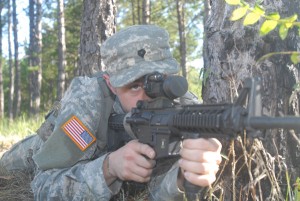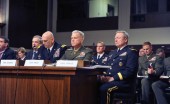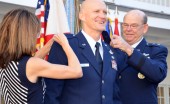Cavalry Soldiers test to earn their spurs
Written by Staff // September 27, 2011 // Feature Stories, News
By Staff Sgt. Derrol Fulghum
FORT RUCKER, Ala. (Sept. 10, 2011) – The 1st Squadron, 153rd Cavalry Regiment conducted a spur ride recently to give Soldiers a chance to obtain good training and earn the cavalry’s coveted silver spur.

Soldiers from the Florida National Guard's 1st Squadron, 153rd Cavalry Regiment conduct a team stress event while trying to earn their silvers spurs during a Spur Ride at Fort Rucker, Ala., Sept. 10, 2011. The Soldiers were tested both physically and mentally to earn their traditional cavalry spurs. Photo by Staff Sgt. Derrol Fulghum
In the past, when new troops would sign up for the cavalry, they had many skills to learn: shooting, scouting and using a saber – all from horseback. These new recruits were issued horses and sabers, but not spurs.
Until the new Soldiers could effectively perform and be integrated into the unit, they needed a little extra room to maneuver. Therefore, the tails of their horses were shaved and they weren’t given spurs so veterans knew where they were. They became known as “shavetails.”
After months of intense training, if they proved themselves worthy by completing a ride during which they demonstrated a proficiency in all the skills they were taught, the recruits were given their silver spurs as a sign that they were ready to join the troop in combat.

A Soldier with the Florida National Guard's 1st Squadron, 153rd Cavalry Regiment participates in a team stress event during a recent Spur Ride event at Fort Rucker, Ala. Soldiers from the Squadron completed rigorous physical and mental testing to earn their cavalry spurs. Photo by Staff Sgt. Derrol Fulghum
Though horses are no longer used, the modern day cavalry holds to their proud traditions by authorizing the wear of Stetsons and spurs – if a Soldier can earn them.
Today’s spur rides are intense two-day events testing a Soldier both mentally and physically. The ride sponsored by the 1-153rd required aspirants to march ten miles with a 25-lb ruck sack in less than three hours and thirty minutes. They marched to different stations where they were tested on common warrior tasks, such as deploying a Claymore mine, calling for fire, land navigation, hand and arm signals and first aid.
2nd Lt. Tim Blyndenburgh, with Troop A, earned his spurs over the weekend. Lowering himself to the ground after nine grueling hours, covered in dirt and sweat, he said, “On a day like today, when the sun is out, and you’re tired and hungry, the only thing keeping you going is your pride.”
Indeed, pride seems to be the driving factor for Soldiers striving to earn their spurs. Pfc. Ernest Nixon, also a newly-spurred Soldier acting as the leader of his team said, “I want to prove to my chain of command that I am a leader. Most of them have their spurs, and I want mine, too.”

A Soldier from the Florida National Guard's 1st Squadron, 153rd Cavalry Regiment assumes a prone firing position while moving under direct fire in order to earn his silver spurs at Fort Rucker, Ala. Photo by Staff Sgt. Derrol Fulghum
The mental aspect of performing 16 warrior tasks flawlessly seems daunting enough. In addition, each of the five stations also featured a team stress event. A Humvee pull, carrying a zodiac raft weighted down with ruck sacks, low crawling through mud under a bridge made by the bodies of your team – these are the things aspirants were required to do.
Of the more than 150 aspirants, only 46 made the cut. 1st Lt. Andrew Wolltman, fire support officer for Headquarters and Headquarters Troop, earned his spurs a few years ago. “It’s a matter of camaraderie and brother-or-sisterhood. It’s great for morale, and its good training.”
Headquartered in Panama City, the squadron has subordinate units-called “troops”-in Bonifay, Chipley, Pensacola and Tallahassee.
###















